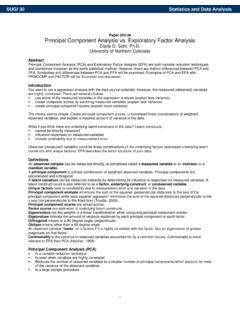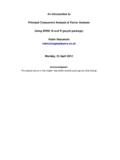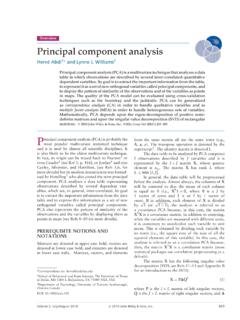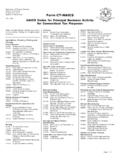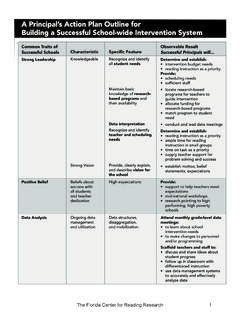Transcription of PRINCIPAL COMPONENT ANALYSIS - SAS Support
1 1 Chapter 1 PRINCIPAL COMPONENT ANALYSISI ntroduction: The Basics of PRINCIPAL COMPONENT ANALYSIS .. 2A Variable Reduction Procedure .. 2An Illustration of Variable Redundancy .. 3 What is a PRINCIPAL COMPONENT ? .. 5 How PRINCIPAL components are computed .. 5 Number of components extracted .. 7 Characteristics of PRINCIPAL components .. 7 Orthogonal versus Oblique Solutions .. 8 PRINCIPAL COMPONENT ANALYSIS is Not Factor ANALYSIS .. 9 Example: ANALYSIS of the Prosocial Orientation Inventory .. 10 Preparing a Multiple-Item Instrument .. 11 Number of Items per COMPONENT .. 12 Minimally Adequate Sample Size .. 13 SAS Program and Output .. 13 Writing the SAS Program .. 14 The DATA step.
2 14 The PROC FACTOR statement .. 15 Options used with PROC FACTOR .. 15 The VAR statement .. 17 Example of an actual program .. 17 Results from the Output .. 17 Steps in Conducting PRINCIPAL COMPONENT ANALYSIS .. 21 Step 1: Initial Extraction of the Components .. 21 Step 2: Determining the Number of Meaningful Components to Retain .. 22 Step 3: Rotation to a Final Solution .. 28 Factor patterns and factor loadings .. 28 Rotations .. 28 Step 4: Interpreting the Rotated Solution .. 28 Step 5: Creating Factor Scores or Factor-Based Scores .. 31 Computing factor scores .. 32 Computing factor-based scores .. 36 Recoding reversed items prior to ANALYSIS .. 38 Step 6: Summarizing the Results in a Table.
3 40 Step 7: Preparing a Formal Description of the Results for a Paper .. 412 PRINCIPAL COMPONENT AnalysisAn Example with Three Retained Components .. 41 The Questionnaire .. 41 Writing the Program .. 43 Results of the Initial ANALYSIS .. 44 Results of the Second ANALYSIS .. 50 Conclusion .. 55 Appendix: Assumptions Underlying PRINCIPAL COMPONENT ANALYSIS .. 55 References .. 56 Overview. This chapter provides an introduction to PRINCIPAL COMPONENT ANALYSIS : avariable-reduction procedure similar to factor ANALYSIS . It provides guidelines regardingthe necessary sample size and number of items per COMPONENT . It shows how to determinethe number of components to retain, interpret the rotated solution, create factor scores, andsummarize the results.
4 Fictitious data from two studies are analyzed to illustrate theseprocedures. The present chapter deals only with the creation of orthogonal (uncorrelated)components; oblique (correlated) solutions are covered in Chapter 2, Exploratory FactorAnalysis .Introduction: The Basics of PRINCIPAL COMPONENT AnalysisPrincipal COMPONENT ANALYSIS is appropriate when you have obtained measures on a number ofobserved variables and wish to develop a smaller number of artificial variables (called principalcomponents) that will account for most of the variance in the observed variables. The principalcomponents may then be used as predictor or criterion variables in subsequent Variable Reduction Procedure PRINCIPAL COMPONENT ANALYSIS is a variable reduction procedure.
5 It is useful when you haveobtained data on a number of variables (possibly a large number of variables), and believe thatthere is some redundancy in those variables. In this case, redundancy means that some of thevariables are correlated with one another, possibly because they are measuring the sameconstruct. Because of this redundancy, you believe that it should be possible to reduce theobserved variables into a smaller number of PRINCIPAL components (artificial variables) that willaccount for most of the variance in the observed variables. PRINCIPAL COMPONENT ANALYSIS 3 Because it is a variable reduction procedure, PRINCIPAL COMPONENT ANALYSIS is similar in manyrespects to exploratory factor ANALYSIS . In fact, the steps followed when conducting a principalcomponent ANALYSIS are virtually identical to those followed when conducting an exploratoryfactor ANALYSIS .
6 However, there are significant conceptual differences between the twoprocedures, and it is important that you do not mistakenly claim that you are performing factoranalysis when you are actually performing PRINCIPAL COMPONENT ANALYSIS . The differencesbetween these two procedures are described in greater detail in a later section titled PrincipalComponent ANALYSIS is Not Factor ANALYSIS . An Illustration of Variable RedundancyA specific (but fictitious) example of research will now be presented to illustrate the concept ofvariable redundancy introduced earlier. Imagine that you have developed a 7-item measure ofjob satisfaction. The instrument is reproduced here:Please respond to each of the following statements by placing arating in the space to the left of the statement.
7 In making yourratings, use any number from 1 to 7 in which 1= strongly disagree and 7= strongly agree. _____ 1. My supervisor treats me with 2. My supervisor consults me concerning important decisionsthat affect my 3. My supervisors give me recognition when I do a good 4. My supervisor gives me the Support I need to do my 5. My pay is 6. My pay is appropriate, given the amount of responsibilitythat comes with my 7. My pay is comparable to the pay earned by other employeeswhose jobs are similar to you began your investigation with the intention of administering this questionnaire to200 or so employees, and using their responses to the seven items as seven separate variables insubsequent analyses (for example, perhaps you intended to use the seven items as seven separatepredictor variables in a multiple regression equation in which the criterion variable was intention to quit the organization ).
8 4 PRINCIPAL COMPONENT AnalysisThere are a number of problems with conducting the study in this fashion, however. One of themore important problems involves the concept of redundancy that was mentioned earlier. Take aclose look at the content of the seven items in the questionnaire. Notice that items 1-4 all dealwith the same topic: the employees satisfaction with their supervisors. In this way, items 1-4are somewhat redundant to one another. Similarly, notice that items 5-7 also all seem to dealwith the same topic: the employees satisfaction with their findings may further Support the notion that there is redundancy in the seven items. Assume that you administer the questionnaire to 200 employees and compute all possiblecorrelations between responses to the 7 items.
9 The resulting fictitious correlations arereproduced in Table :Table among Seven Job Satisfaction Items_____ Correlations _____Variable 1 2 3 4 5 6 7_____ 1 2 .75 3 .83 .82 4 .68 .92 .88 5 .03 .01 .04 .01 6 .05 .02 .05 .07 .89 7 .02 .06 .00 .03 .91 .76 : N = correlations among several variables are computed, they are typically summarized in theform of a correlation matrix, such as the one reproduced in Table This is an appropriateopportunity to review just how a correlation matrix is interpreted. The rows and columns ofPrincipal COMPONENT ANALYSIS 5 Table correspond to the seven variables included in the ANALYSIS : Row 1 (and column 1)represents variable 1, row 2 (and column 2) represents variable 2, and so forth.
10 Where a givenrow and column intersect, you will find the correlation between the two corresponding variables. For example, where the row for variable 2 intersects with the column for variable 1, you find acorrelation of .75; this means that the correlation between variables 1 and 2 is .75. The correlations of Table show that the seven items seem to hang together in two distinctgroups. First, notice that items 1-4 show relatively strong correlations with one another. Thiscould be because items 1-4 are measuring the same construct. In the same way, items 5-7correlate strongly with one another (a possible indication that they all measure the sameconstruct as well). Even more interesting, notice that items 1-4 demonstrate very weakcorrelations with items 5-7.










